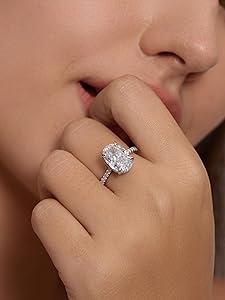Oval cut diamonds are beloved for their graceful shape and vintage-meets-modern appeal, but what truly sets them apart is how they handle light. Known for their brilliant sparkle, oval diamonds offer an elegant elongated silhouette with the fiery brilliance of a round cut—when cut correctly. But not all ovals perform equally. If you're considering an oval cut engagement rings, understanding light performance is key to selecting a stone that dazzles.
At KRK Jewels, we know that a diamond’s beauty comes down to how it plays with light. Let’s explore what influences light performance in oval cut diamonds and how to choose one that radiates with exceptional brilliance.
What Is Light Performance?
Light performance refers to how well a diamond reflects, refracts, and disperses light. This determines its brilliance (white light return), fire (colored flashes), and scintillation (sparkle as it moves). In oval diamonds, proper proportions and cutting precision are essential for achieving high light performance.
Factors That Affect Light Performance in Oval Cuts
1. Cut Quality
Unlike round diamonds, oval cuts aren’t graded by GIA for cut. That means cut quality must be evaluated visually and with expert guidance. A well-cut oval will reflect light evenly across the entire surface and avoid dark, dead zones.
Key things to look for:
-
Excellent symmetry
-
Proper faceting arrangement
-
Balanced length-to-width ratio (ideal is around 1.35 to 1.50)
-
Minimal to no bow-tie effect (explained below)
2. The Bow-Tie Effect
One of the most talked-about features of oval diamonds is the bow-tie effect—a dark area that runs across the center of the stone resembling a bow tie. This shadow occurs when the diamond isn’t cut in a way that reflects light evenly. While all oval diamonds show some degree of bow-tie, the best-cut stones display a subtle or barely visible one.
At KRK Jewels, we help clients assess this by offering high-resolution videos and in-person viewings to evaluate how light moves through the stone from all angles.
3. Depth and Table Proportions
The depth percentage and table percentage significantly impact how light is returned to the eye.
-
Ideal depth: 59% to 63%
-
Ideal table: 53% to 63%
Too shallow and the light escapes from the bottom; too deep and it leaks from the sides, reducing sparkle. Aim for balanced proportions that maximize brightness without compromising the stone’s shape.
How to Choose an Oval Diamond with Great Light Performance
-
Always View the Diamond in Motion
Sparkle isn’t static. View the diamond in person or through video while it's moving under various lighting conditions—sunlight, LED, and diffuse lighting. -
Avoid Poor Symmetry
Uneven sides or misaligned facets can disrupt light flow, causing dullness and uneven sparkle. Always choose a stone with Very Good to Excellent symmetry. -
Use a Light Performance Imaging Tool
Tools like ASET (Angular Spectrum Evaluation Tool) or Ideal Scope show how light is returned. A good oval diamond will show even color distribution and minimal light leakage. -
Consult with Experts
KRK Jewels offers personalized consultations to help you evaluate cut proportions, eliminate strong bow-tie stones, and select a diamond with verified brilliance.
Final Thoughts
Oval cut diamonds have the potential to deliver breathtaking light performance—but only when expertly chosen. From minimizing the bow-tie effect to selecting the right depth and table proportions, every detail matters. The reward? A diamond that sparkles with brilliance from every angle and enhances the beauty of your hand.
At KRK Jewels, we carefully curate our collection of oval cut diamonds to ensure each one meets our highest standards for light performance. Whether you’re shopping online or in-store, let us guide you to the perfect stone that captures the light—and your heart.



